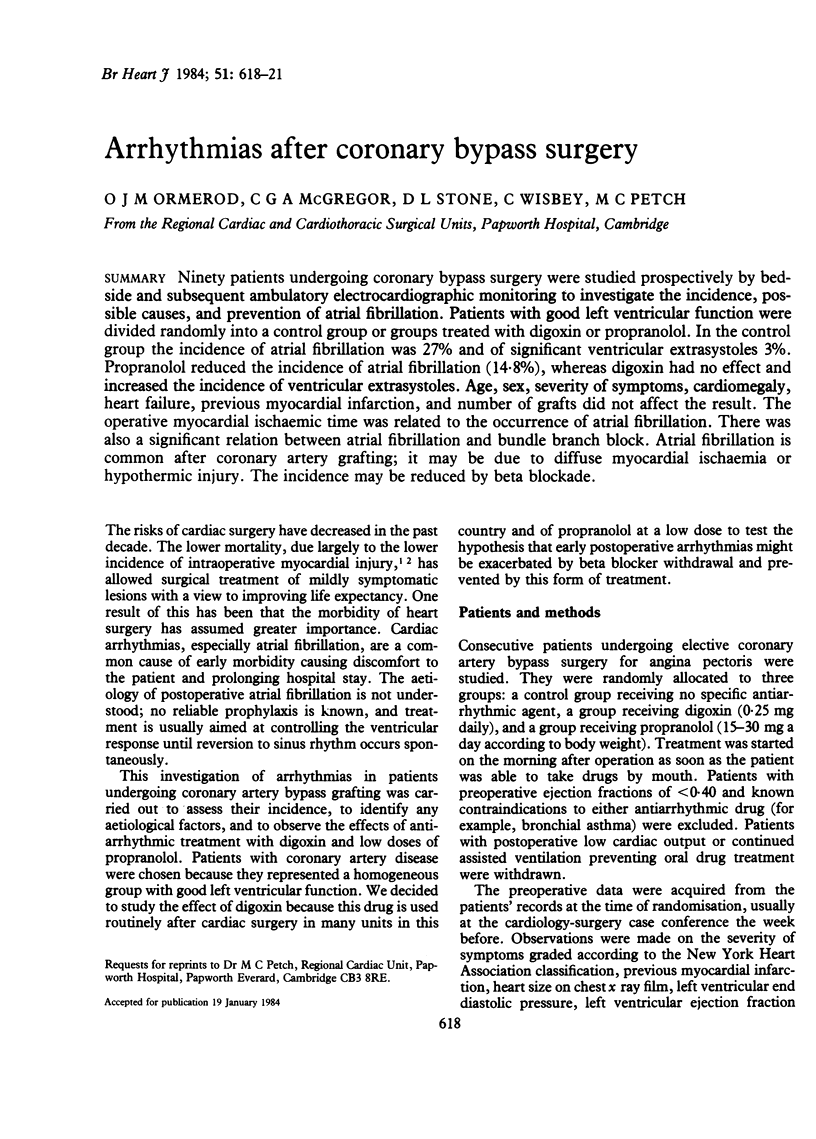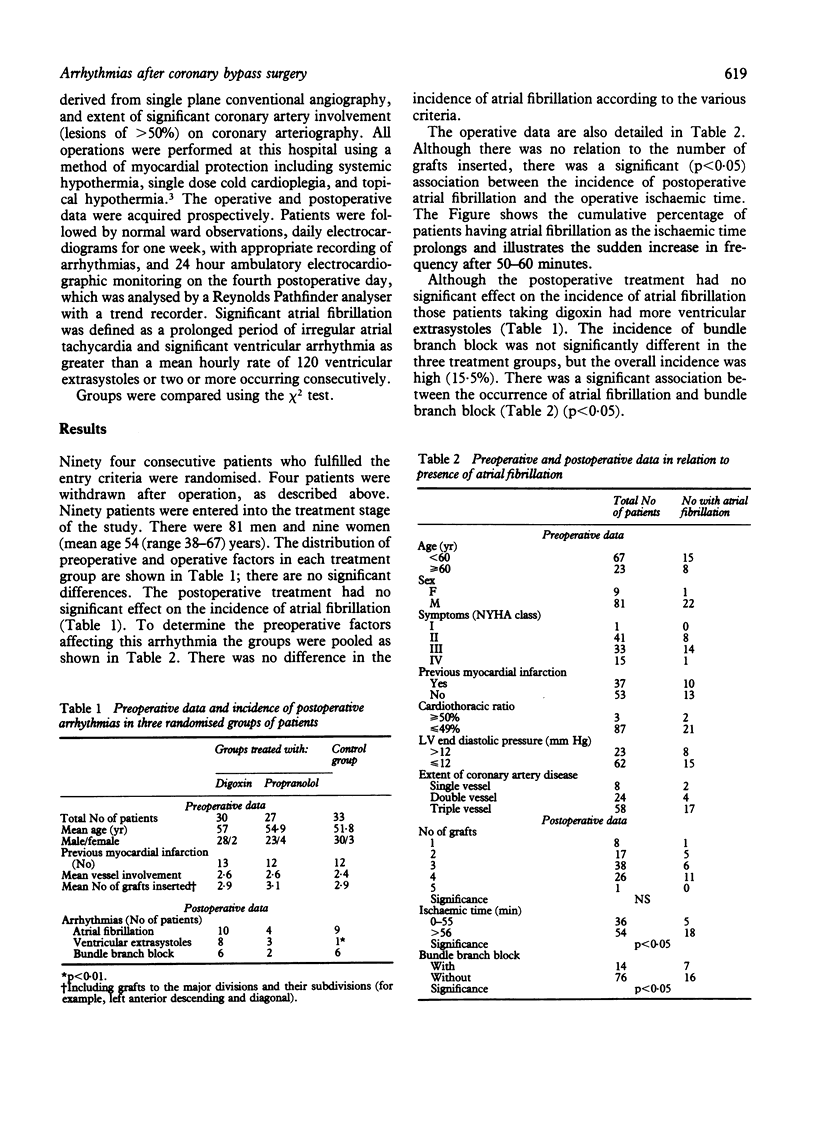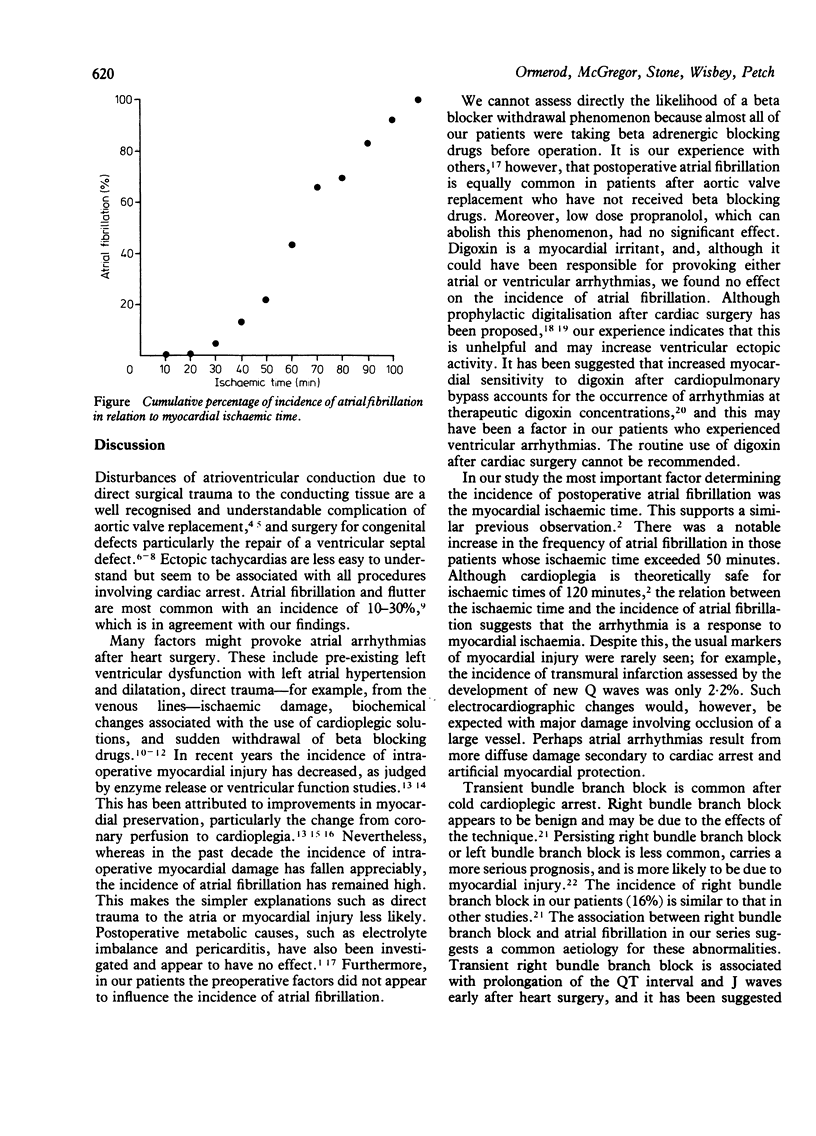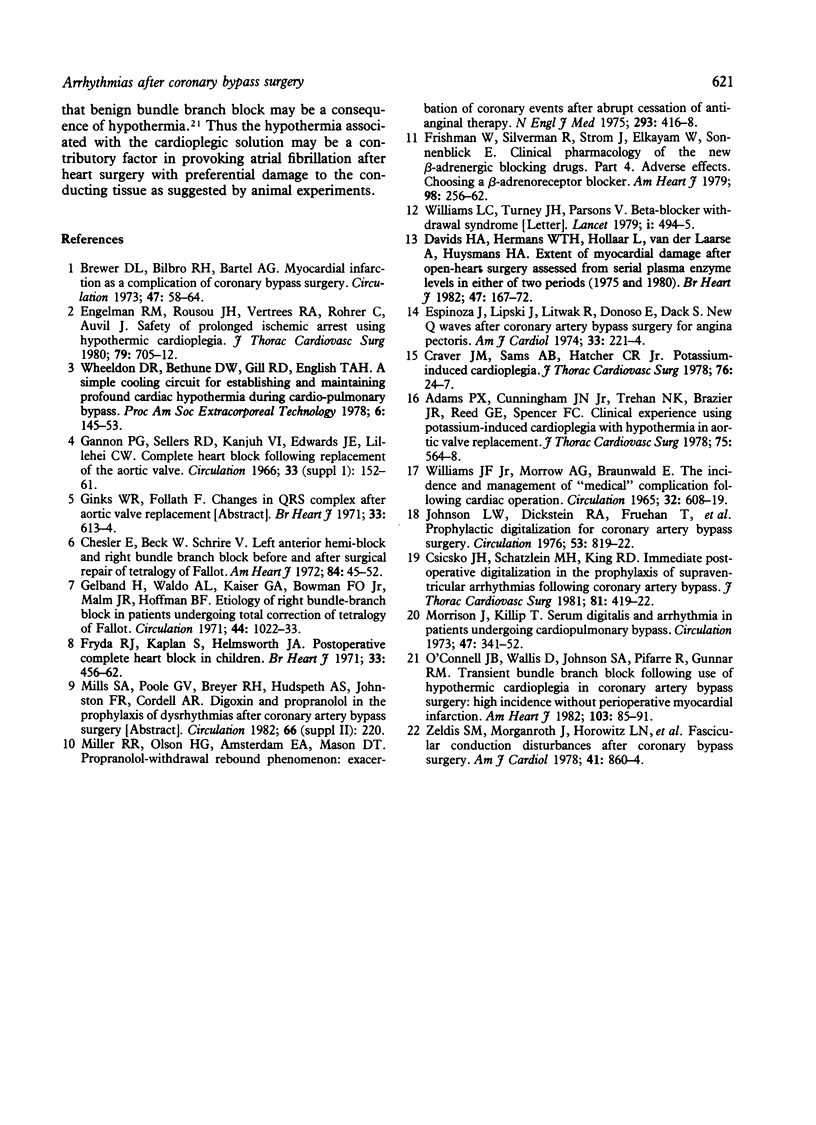Abstract
Ninety patients undergoing coronary bypass surgery were studied prospectively by bedside and subsequent ambulatory electrocardiographic monitoring to investigate the incidence, possible causes, and prevention of atrial fibrillation. Patients with good left ventricular function were divided randomly into a control group or groups treated with digoxin or propranolol. In the control group the incidence of atrial fibrillation was 27% and of significant ventricular extrasystoles 3%. Propranolol reduced the incidence of atrial fibrillation (14.8%), whereas digoxin had no effect and increased the incidence of ventricular extrasystoles. Age, sex, severity of symptoms, cardiomegaly, heart failure, previous myocardial infarction, and number of grafts did not affect the result. The operative myocardial ischaemic time was related to the occurrence of atrial fibrillation. There was also a significant relation between atrial fibrillation and bundle branch block. Atrial fibrillation is common after coronary artery grafting; it may be due to diffuse myocardial ischaemia or hypothermic injury. The incidence may be reduced by beta blockade.
Full text
PDF



Selected References
These references are in PubMed. This may not be the complete list of references from this article.
- Adams P. X., Cunningham J. N., Jr, Trehan N. K., Brazier J. R., Reed G. E., Spencer F. C. Clinical experience using potassium-induced cardioplegia with hypothermia in aortic valve replacement. J Thorac Cardiovasc Surg. 1978 Apr;75(4):564–568. [PubMed] [Google Scholar]
- Brewer D. L., Bilbro R. H., Bartel A. G. Myocardial infarction as a complication of coronary bypass surgery. Circulation. 1973 Jan;47(1):58–64. doi: 10.1161/01.cir.47.1.58. [DOI] [PubMed] [Google Scholar]
- Chesler E., Beck W., Schrire V. Left anterior hemiblock and right bundle branch block before and after surgical repair of tetralogy of Fallot. Am Heart J. 1972 Jul;84(1):45–52. doi: 10.1016/0002-8703(72)90304-3. [DOI] [PubMed] [Google Scholar]
- Craver J. M., Sams A. B., Hatcher C. R., Jr Potassium-induced cardioplegia. Additive protection against ischemic myocardial injury during coronary revascularization. J Thorac Cardiovasc Surg. 1978 Jul;76(1):24–27. [PubMed] [Google Scholar]
- Csicsko J. F., Schatzlein M. H., King R. D. Immediate postoperative digitalization in the prophylaxis of supraventricular arrhythmias following coronary artery bypass. J Thorac Cardiovasc Surg. 1981 Mar;81(3):419–422. [PubMed] [Google Scholar]
- Davids H. A., Hermens W. T., Hollaar L., van der Laarse A., Huysmans H. A. Extent of myocardial damage after open-heart surgery assessed from serial plasma enzyme levels in either of two periods (1975 and 1980). Br Heart J. 1982 Feb;47(2):167–172. doi: 10.1136/hrt.47.2.167. [DOI] [PMC free article] [PubMed] [Google Scholar]
- Engelman R. M., Rousou J. H., Vertrees R. A., Rohrer C., Auvil J. Safety of prolonged ischemic arrest using hypothermic cardioplegia. J Thorac Cardiovasc Surg. 1980 May;79(5):705–712. [PubMed] [Google Scholar]
- Espinoza J., Lipski J., Litwak R., Donoso E., Dack S. New Q waves after coronary artery bypass surgery for angina pectoris. Am J Cardiol. 1974 Feb;33(2):221–224. doi: 10.1016/0002-9149(74)90278-1. [DOI] [PubMed] [Google Scholar]
- Frishman W., Silverman R., Strom J., Elkayam U., Sonnenblick E. Clinical pharmacology of the new beta-adrenergic blocking drugs. Part 4. Adverse effects. Choosing a beta-adrenoreceptor blocker. Am Heart J. 1979 Aug;98(2):256–262. doi: 10.1016/0002-8703(79)90229-1. [DOI] [PubMed] [Google Scholar]
- Fryda R. J., Kaplan S., Helmsworth J. A. Postoperative complete heart block in children. Br Heart J. 1971 Jul;33(4):456–462. doi: 10.1136/hrt.33.4.456. [DOI] [PMC free article] [PubMed] [Google Scholar]
- Gelband H., Waldo A. L., Kaiser G. A., Bowman F. O., Jr, Malm J. R., Hoffman B. F. Etiology of right bundle-branch block in patients undergoing total correction of tetralogy of Fallot. Circulation. 1971 Dec;44(6):1022–1033. doi: 10.1161/01.cir.44.6.1022. [DOI] [PubMed] [Google Scholar]
- Ginks W. R., Follath F. Changes in QRS compledx after aortic valve replacement. Br Heart J. 1971 Jul;33(4):613–614. [PubMed] [Google Scholar]
- Johnson L. W., Dickstein R. A., Fruehan C. T., Kane P., Potts J. L., Smulyan H., Webb W. R., Eich R. H. Prophylactic digitalization for coronary artery bypass surgery. Circulation. 1976 May;53(5):819–822. doi: 10.1161/01.cir.53.5.819. [DOI] [PubMed] [Google Scholar]
- Miller R. R., Olson H. G., Amsterdam E. A., Mason D. T. Propranolol-withdrawal rebound phenomenon. Exacerbation of coronary events after abrupt cessation of antianginal therapy. N Engl J Med. 1975 Aug 28;293(9):416–418. doi: 10.1056/NEJM197508282930902. [DOI] [PubMed] [Google Scholar]
- Morrison J., Killip T. Serum digitalis and arrhythmia in patients undergoing cardiopulmonary bypass. Circulation. 1973 Feb;47(2):341–352. doi: 10.1161/01.cir.47.2.341. [DOI] [PubMed] [Google Scholar]
- Williams J. F., Jr, Morrow A. G., Braunwald E. The incidence and management of "medical" complications following cardiac operations. Circulation. 1965 Oct;32(4):608–619. doi: 10.1161/01.cir.32.4.608. [DOI] [PubMed] [Google Scholar]
- Williams L. C., Turney J. H., Parsons V. Beta-blocker withdrawal syndrome. Lancet. 1979 Mar 3;1(8114):494–495. doi: 10.1016/s0140-6736(79)90848-1. [DOI] [PubMed] [Google Scholar]
- Zeldis S. M., Morganroth J., Horowitz L. N., Michelson E. L., Josephson M. E., Lozner E. C., MacVaugh H., 3rd, Kastor J. A. Fascicular conduction distrubances after coronary bypass surgery. Am J Cardiol. 1978 May 1;41(5):860–864. doi: 10.1016/0002-9149(78)90725-7. [DOI] [PubMed] [Google Scholar]


